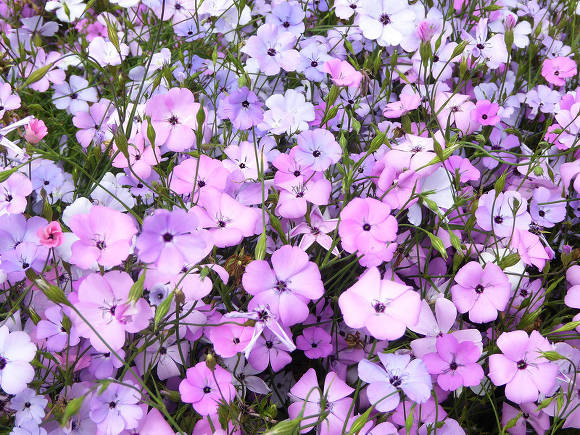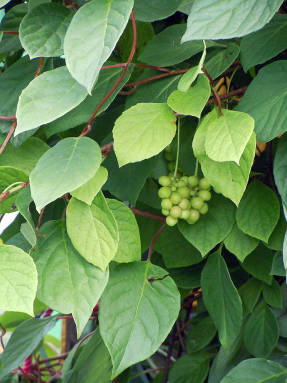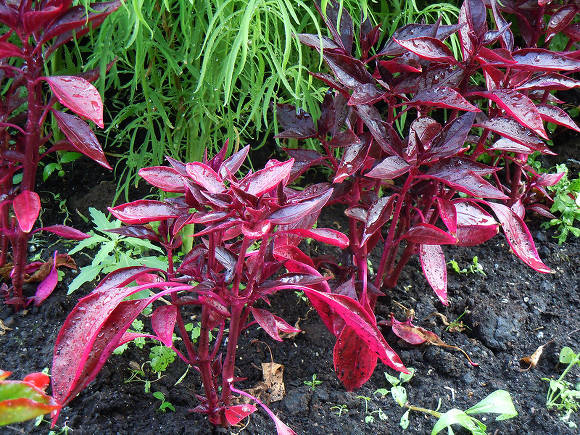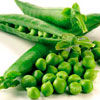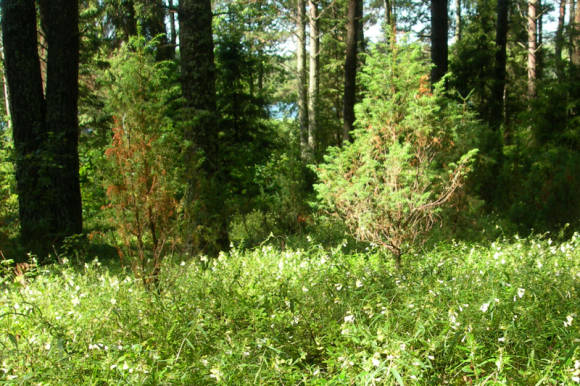
Foreign nasturtium was originally named Canarian nasturtium (Tropaeolum canariense), because it was first described from the Canary Islands. Later it turned out that it comes from the west of South America - the territory of Peru and, presumably, Ecuador. This species belongs to the same genus nasturtium as the more familiar types of nasturtium. The plant has been cultivated since 1720, but it has not become widespread in our country due to its thermophilicity.
Despite the fact that the plant is perennial, in temperate climates it is grown as an annual, its winter hardiness is limited to -6 degrees. But, thanks to the long-term nature, foreign nasturtium can successfully grow in greenhouses and winter gardens, where it remains green all year round.
Foreign nasturtium (Tropaeolum peregrinum) is a gentle herbaceous climbing plant up to 2.5 m high, braiding vegetation in nature. Stems are juicy, glabrous, branched, without support, weak, ascending. Leaves on long purple petioles, 2-5 cm in diameter, rounded in outline, reniform or thyroid, palmate-lobed, consisting of 3-7 (usually 5) obtuse or oblong obtuse mint-green lobes, with a solid edge. Flowers with a diameter of 2-4 cm, with five fringedly dissected yellow petals, the lower ones often with red spots at the base, with eight stamens and a long, up to 1.3 cm, yellowish-green nectar spur.
The two larger petals in the flower are "tousled" upwards, and the three smaller ones are clustered at the bottom. Their bright, cheerful yellow shades and external outlines resemble the wings of canaries, hence the English-language name of the plant - Canary Creeper (canary), literally translated - canary creeping plant.

The plant has a strong and deep root system. It develops quickly, without support forms a continuous cover 25-35 cm high. On the support it twists with stems. It blooms from June to frost with numerous flowers. The seeds in the middle lane often do not ripen.
Reproduction of foreign nasturtium
Like other nasturtiums, this species is grown from seed. In temperate climates, 6-8 week old seedlings should be grown. For planting in early June, foreign nasturtium must be sown in early April.
The seeds have a hard shell and germinate better after scarification. The easiest way is to soak them overnight. But you can first gently rub the seeds with sandpaper, and then soak them. After that, they start sowing.
Seeds are sown in pots to a depth of 7-8 mm. Weekly, the soil is slightly moistened to a depth of 2.5-5 cm. As soon as the seeds sprout, and usually this happens on the 10th day, they begin to gently water the seedlings daily.
Plants are planted in open ground with the end of the frost period.
Not everyone knows that nasturtiums can be grafted. And foreign nasturtium too. It takes root easily both in water and in wet sand. It is advisable to use this breeding method if you want to take it to the winter garden for the winter.
 |  |
Growing foreign nasturtium
Growing conditions... Foreign nasturtium is very thermophilic and sensitive to cold; it needs to choose a sunny, warm place from the south or east. In warm regions, the plant tolerates partial shade, but it may bloom worse. The warmer the season is, the longer the growing season and flowering continue.
The soil... Foreign nasturtium can be grown on almost any soils of weak and neutral acidity (pH 6.0-7.2). The main requirement is that the soil must be drained, without stagnant water. It thrives even better on poor, sandy soils than on rich ones. But with good moisture supply.
Watering... Before flowering, regular watering is required, and with the beginning of flowering - only when the soil dries out.
Top dressing also carried out before flowering, mainly with phosphorus-potassium fertilizers. An excess of nutrients leads to an increase in foliage size and mass, but impairs flowering.On moderately rich garden soil, you can not apply mineral fertilizers at all, if the lower leaves do not turn yellow.
Pests... Of the pests on the plant, aphids can sometimes appear. It can be washed off with water from a hose, treated with green soap or chemical insecticides (Spark, Fufanon, etc.).
Use in garden design
The flowers of foreign nasturtium, although bright, are not so large as to be clearly visible from a distance. Therefore, it is useful to plant other plants with blue, purple, red flowers nearby, providing a background for them.
Foreign nasturtium is beautiful in flower beds, on balconies, in hanging baskets. It can grow in a ground cover crop, but even better - on supports. Effectively wraps around pillars, obelisks, pillars of arbors, fences and trellises. The best and most comfortable for her are thin supports.
The carved, rounded leaves are magnificent on their own, without flowers. But blooming trellis made of foreign nasturtium, covered with many yellow flowers - "canaries" - is an exotic sight.

Bright yellow flowers attract all kinds of beneficial insects to the garden - butterflies, bumblebees, bees. Many gardeners plant foreign nasturtium with wildflowers to create a butterfly garden. But it must be borne in mind that vigorous growth of vines can sometimes overwhelm neighboring non-competitive plants.
In English gardens, this nasturtium can often be seen in ornamental gardens. There is nothing surprising. Its leaves are edible and healthy, just like the leaves of regular nasturtium. However, flowers, seeds and even stems are also edible, they all have a characteristic pungent aroma. Young seeds are used as a substitute for capers, and leaves and flowers are added to salads. Nasturtium flowers are also used as a spice in oils, soups and, for example, in the national American dish gumbo, which is a cross between soup and stew.
Try to sentence something from nasturtium:
- Nasturtium salad with radish
- Nasturtium salad with carrots
- Green salad with nasturtium
- Spring cabbage soup with nasturtium
- Vinegar with herbs "Czech"
- Late summer salad with nasturtiums
- Cucumber salad with sweet clover and nasturtium leaves
- Seasoning from nasturtium flowers
- Nasturtium flower jam



